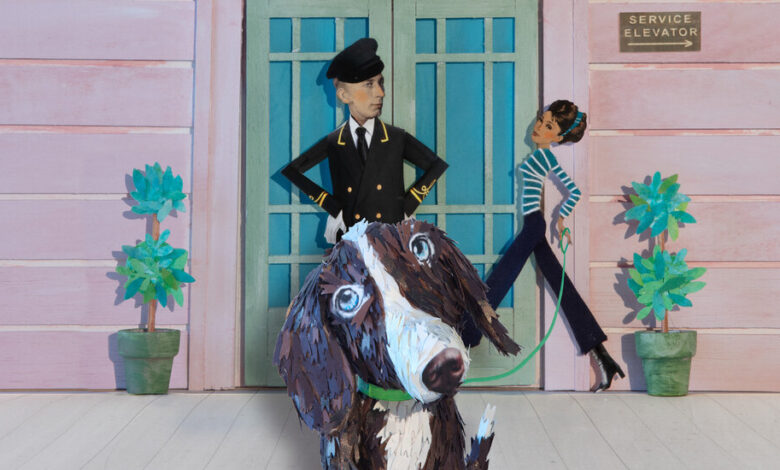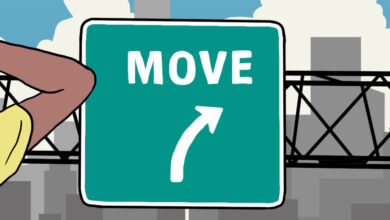In Some Buildings, Dogs Go Out With the Trash

[ad_1]
Though he says he has lived in Barclay Tower, a 58-story residential building in Manhattan’s TriBeCa for over a decade, Jeno Steiner has barely lingered in its resplendent lobby. He rarely sees the striated marble floors trimmed with handcrafted stone mosaics, the cornices of French chiseled limestone, or the seating areas of Japanese tamo ash and teak.
That’s because his roommate is not allowed to step foot underneath its barrel-vaulted ceilings.
Baxter, Mr. Steiner’s fluffy 10-year-old Shih-Poo, may only walk through the service entrance, where building rules insist all dogs squeeze alongside the Seamless deliveries, bicycles and moving crews. They may cross the lobby in one instance, Mr. Steiner said: carried by their owners.
“I’ve gotten so used to it, I’ve even brought guests up through the service entrance,” said Mr. Steiner, 54, who runs a fetish wear company with his husband. He spoke as he and Baxter stepped out the side door, about 50 feet from the glamorous lobby, past a bike messenger and a housekeeper, for their afternoon constitutional.
Yet even in a building where a one-bedroom rented last month for nearly $7,000, Mr. Steiner said he doesn’t mind that Baxter, and by extension, he himself, is shunned from the glamorous lobby. It could be worse. When he first moved in, he said, it was a pet-free building: “I was just happy to be allowed to have a dog.”
Of the many house rules and regulations that make the collective cohabitation that is apartment dwelling bearable, policies around pets are typically made plain: Some buildings have no-pet restrictions, others limit dogs by size and breed, while others are so pet friendly that they offer dog treats at the front desk. But an in-between area exists in some residences. Within them, dogs are welcome, but not welcome everywhere. Most typically, the situation occurs in large luxury buildings where ancillary elevator banks and building bylaws are used to divide dogs from the dog-less, the allergic or the afraid.
Sometimes the canine restrictions are longstanding; other times they can catch people off guard when they are suddenly instated after, say, one too many pug versus papillon standoffs in the lobby or an incontinent mastiff in the elevator. In a city with 425,000 to 600,000 dogs or more, depending on the estimate, and a pandemic puppy rush, even longstanding rules can surprise some tenants. They may have moved in with their pet and glossed over the fine print on the lease of which elevator a dog is permitted to ride.
For some residents, the restrictions about where a dog may walk are minor inconveniences that are tolerated to maintain intra-building peace, another small headache to navigate in a real estate market full of them. For others it has done the opposite: They bristle at paying the same rent as dog-eschewing tenants, while being forced out an inferior exit.
“A lot of people are really offended, a lot of people are emotionally involved with their animals, and a lot of people perceive it as an insult to their pet’s dignity,” said Bruce A. Cholst, a partner at Herrick, Feinstein LLP who specializes in co-op and condo law and has represented clients on both sides of the argument.
Lawsuits and Defiance
Some openly defy the rule. At the 33-story building with a spa near Lincoln Center, on a recent afternoon, a man and a white standard poodle strutted through the lobby beneath its enormous blown-glass chandelier. The duo were flagrantly breaking the building’s rules, according to tenants: dogs must be carried through the lobby, or go through the service exit. And as compliant as Mr. Steiner seems at Barclay Tower, even he has a line in the sand: though they dutifully use the side door, Baxter in fact rides the plush main elevator down even though the service elevator is mandated for dogs. (“He’s the best dog I ever had,” Mr. Steiner said.)
Still others have sued to let their dogs rove their building as they please. But, with the exception of service dogs, who are required by law to be permitted to go where their owners need them, there is no guarantee a dog owner will be successful in court, said Mr. Cholst, the lawyer. Most often, such cases are resolved privately with “imaginative solutions,” he said, such as a dog owner being permitted to take the elevator, but obligated to wait for the next one if a person who dislikes their dog is aboard.
Some buildings have established fines for those who refused to use the doggy door. Late last year, Lia Pettigrew’s Upper West Side apartment building sent an email warning that fines could be imposed for anyone walking their dog through the lobby, rather than the side entrance, she said. Ms. Pettigrew, a semiretired consultant, was aghast. She has vowed to fight it — even though she doesn’t have a dog herself.
“It is a slippery slope. If landlords are allowed to impose fines for your dog walked in the elevator, or your dog stepped foot in the lobby, what’s next?” she said. ‘Your dog barked — $50’? ‘Your child yelled’?”
Funneling different types of tenants through different entrances has been a fraught subject in the city: In 2015, following an uproar, New York City banned separate entrances for people paying market rate for their apartments versus people in subsidized housing in the same building. The setup employed by large developers to segregate the subsidized from the wealthy was known colloquially as a “poor door.”
Walking past the dog door at Barclay Tower with his miniature goldendoodle Claire, Lenny Fein, who lives nearby in a building that lets Claire come and go as she pleases, was concerned such rules might similarly imply second class citizenry to dog owners. “It’s sort of sad,” Mr. Fein said.
The Red Carpet for Rover?
With rising interests rates, apartment sales have become sluggish; in the second half of last year sales of the city’s most costly apartments slowed significantly. With buildings eager to attract tenants, many are abandoning restrictive dog rules, said Ryan Serhant, a real estate broker and the chief executive officer and founder of the brokerage, Serhant. “The market is being tougher, and more people have dogs,” he said. “If you’re a building and you’re going to have dog restrictions, you are restricting now a very large part of the population. You’re going to end up with a lower value building.”
The city is now on tail end of the dog restriction trend and is now moving into rolling out the red carpet for Rover. In 2018, Stewart House, a residential co-op building in Greenwich Village that at one point in its history forbade fish and hamsters as well as dogs and cats, changed its rules to allow dogs.
The dog friendliness extends to Serhant’s Manhattan headquarters, where the office mascot, Ollie, a golden retriever-Cavalier King Charles spaniel cross breed goes where he pleases.
“That dog gets the front door treatment,” Mr. Serhant said.
About 75 percent of buildings in New York City accommodate pets, according to Jonathan Miller, the president of Miller Samuel Real Estate Appraisers & Consultants. Which ones allow them but restrict where they can put their paws is impossible to determine.
Indeed, Mr. Cholst, 70, the lawyer, lives in a building on the Upper East Side that has reversed course. When he moved in two decades ago, dogs had to go through the service exit. Today, he is allowed take Sammie-Sue, his pug-poodle mix, and Sean, his Pomeranian-poodle cross breed out the front.
“They very much welcomed the change,” he said. (But just to be safe, in case Sammie-Sue can’t hold it, Mr. Cholst pushes her through the lobby in a stroller.)
Shannon McHale Schachter, 50, a talent agent, refuses to be shunted through the service door at the building on Lincoln Plaza with the other dog owners — and so does her dog, Milo. They have a work around: When she nears the lobby, Milo automatically does a little spin and positions himself to be scooped up by Ms. Schachter. Dogs may not enter the lobby on their own four paws, but they may ferried.
Nevertheless, Ms. Schachter understands the policy. “It could be an elderly dog, or a dog that randomly barfs, or has explosive diarrhea,” she said, with Milo under her right arm. “I get it.”
(Her other dog recently passed away, she said. But even with both animals, the procedure was the same: spin, scoop and tuck under her right arm — except with two small dogs, she stacked them.)
Yet her neighbor, Kristina Dewald, 30, happily slips in and out via the side entrance, between the pizza deliveries and the porters, with her beagle, Lucy.
“Sometimes she wants to get out first thing in the morning, and I’ve literally just opened my eyes,” said Ms. Dewald, who works in data analytics. “Being a dog mom, I don’t get a chance to put makeup on and put nice clothes on,” she said, as she and Lucy ducked out the service entrance on a cold Sunday, both bundled into winter jackets.
“Now I’m feeling like, ‘Oh, thank God, no one can see me, and I can sneak through the service entrance.’”
[ad_2]
Source link






